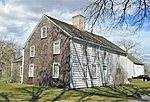West Island (Rhode Island)
West Island is a 9.6 acre (0.015 sq mi) uninhabited island located approximately 0.25 miles (0.4 km) off the coast of Sakonnet Point and roughly 900 feet (274.3 m) east of the Sakonnet Point Lighthouse in Little Compton, Rhode Island, United States. The island is the former site of the West Island Club, an exclusive sport fishing club and hotel, between 1865 and 1906. The island is currently managed by the Sakonnet Preservation Association for use as a nesting sanctuary for shorebirds. Three stone columns and a chimney are the only surviving ruins of the former West Island Club that remain on the island. Public access to the island is permitted during the nesting off-season.
Excerpt from the Wikipedia article West Island (Rhode Island) (License: CC BY-SA 3.0, Authors).West Island (Rhode Island)
Rhode Island Road,
Geographical coordinates (GPS) Address Nearby Places Show on map
Geographical coordinates (GPS)
| Latitude | Longitude |
|---|---|
| N 41.449826 ° | E -71.1983787 ° |
Address
Sakonnet Light
Rhode Island Road
02837
Rhode Island, United States
Open on Google Maps











